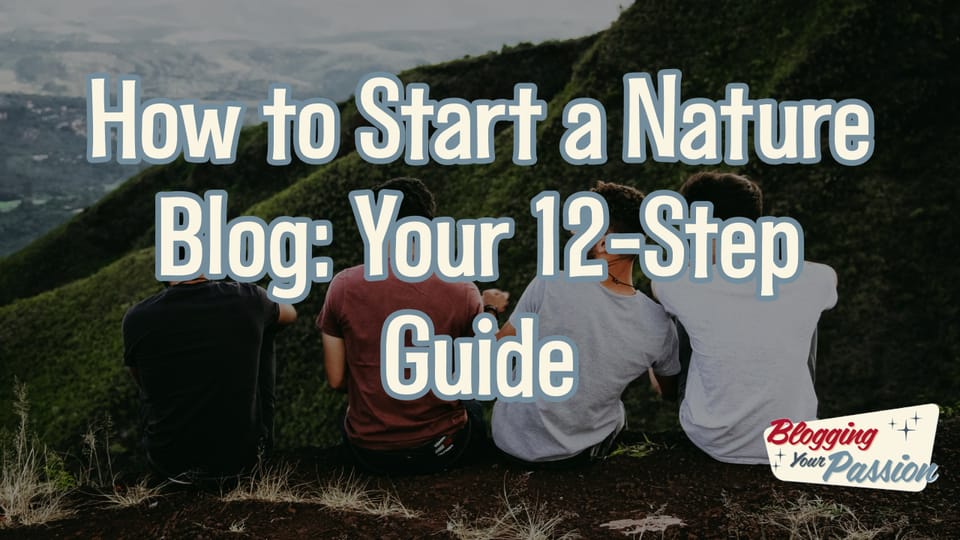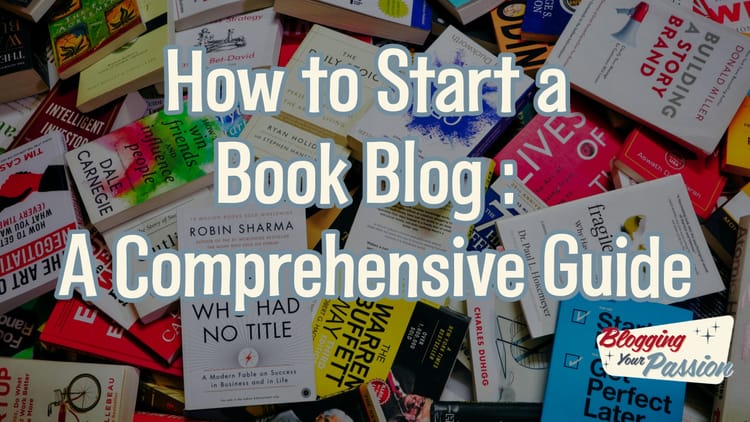How to Start a Nature Blog (2024): Your 12-Step Guide

Are you captivated by the beauty of nature and eager to share your experiences with others?
Starting a nature blog is the perfect way to channel your passion and connect with fellow nature enthusiasts.
But where do you begin?
How can you create a platform that not only showcases your love for the great outdoors, but also engages and educates your readers?
I've been blogging since 2009, and I've seen it all over the years. Fads come and go. Blogging best practices change. Remember blog comments? Yep, they don't happen as much anymore.
At one point, I was running over 12 blogs in various niches. The good news is that almost anything you are passionate about, other people are too. Why not start a blog and build an audience around your passions?
In this post, we will explore the essential steps to kickstart your own nature blog, from choosing your niche to monetizing your content. Let's get started!
Table of Contents (click to expand)
- Step 1. Choose Your Nature Niche
- Step 2. Register a Nature Blog Domain Name
- Step 3. Pick Your Nature Blogging Platform
- Step 4. Design Your Nature Blog Site
- Step 5. Create a Nature Blog About Page
- Step 6. Make a Nature Blog Logo
- Step 7. Optimize Your Nature Content
- Step 8. Promote Your Nature Blog
- Step 9. Connect with Fellow Nature Lovers
- Step 10. Monetize Your Nature Blog
- Step 11. Track Your Nature Blog Metrics
- Step 12. Stay Passionate About Nature
Key Takeaways
- Choose a specific nature niche that you are passionate about to focus your blog on.
- Register a domain name that reflects the nature theme of your blog.
- Select a blogging platform that suits your needs and preferences.
- Design an appealing and user-friendly website for your nature blog.
Step 1. Choose Your Nature Niche
When choosing your nature niche, consider what interests you the most and where your expertise lies. Your nature blog should be a reflection of your passions and knowledge.
Nature journaling is a great way to document your experiences and share them with your audience. You can choose a specific topic within the realm of nature journaling, such as bird watching, plant identification, or nature photography.
By focusing on a specific topic, you can cater to a target audience who shares your interest. This will create a sense of belonging and community among your readers.
To start, think about what aspect of nature you're most drawn to. Is it the beauty of flowers? The serenity of forests? The thrill of spotting rare wildlife?
Consider what you enjoy doing in nature and what you feel confident in sharing with others.
Your expertise and passion will shine through in your writing, making your blog more engaging and informative.
Once you have chosen your nature niche, it's time to decide on a blogging platform. There are many options available, such as WordPress, Blogger, or Squarespace.
Research each platform to determine which one aligns best with your needs and goals. Consider factors like ease of use, customization options, and the ability to reach your target audience.
Step 2. Register a Nature Blog Domain Name
To register a domain name for your nature blog, you'll need to choose a unique and memorable name that reflects the essence of your content. Your domain name is the online address of your blog, so it's important to make it catchy and easy to remember.
Here are some tips to help you register the perfect domain name for your nature blog:
- Choose a name that relates to your nature blog's content: Your domain name should give readers an idea of what your blog is about. Incorporate words like 'nature,' 'outdoors,' or 'wildlife' to make it clear.
- Keep it short and simple: Long and complicated domain names can be difficult to remember and type. Aim for a concise and straightforward name that's easy for your audience to type and recall.
- Make it unique: Check if the domain name you want is available. You don't want to register a domain name that's already in use by another blog or website.
- Consider using keywords: Including relevant keywords in your domain name can help improve your blog's search engine optimization (SEO). Think about what words people might search for when looking for nature-related content.
- Use a reputable domain registrar: There are many domain registrars available, so choose a trusted one that offers reliable services and good customer support.
Step 3. Pick Your Nature Blogging Platform
Consider the different nature blogging platforms available to find the one that best suits your needs and goals. When choosing a platform for your nature blog, it's important to think about your blog name, as well as your own blog ownership and control.
Look for a platform that allows you to have your own domain name, giving your blog a unique and personal touch.
Another aspect to consider is your writing skills and how you want to develop them. Some platforms offer online courses and resources to help you improve your writing and blogging abilities.
These courses can be a valuable investment in your growth as a nature blogger.
Consider the content management system (CMS) provided by the platform. A good CMS will make it easy for you to create and organize your blog posts, upload photos, and manage your blog's layout and design.
Look for a platform that offers a user-friendly CMS that suits your needs and technical abilities.
It's also worth considering the community aspect of the platform. Some platforms have a strong and supportive community of nature bloggers, where you can connect with like-minded individuals, share experiences, and receive feedback on your work.
This sense of belonging can be incredibly motivating and inspiring as you embark on your nature blogging journey.
Step 4. Design Your Nature Blog Site
Once you have chosen the nature blogging platform that best suits your needs and goals, it's time to design your nature blog site. Creating an appealing and user-friendly design will help your audience connect with your content and feel a sense of belonging.
Here are some tips to help you design your nature blog site:
- Choose a visually appealing blog design: Select a design template that complements the theme of your nature blog. Look for layouts that showcase images and allow for easy navigation.
- Find a reliable web host: A reliable web host ensures your blog is accessible to your readers at all times. Look for a host that offers good uptime, fast loading speeds, and excellent customer support.
- Create a harmonious color palette: Choose colors that reflect the beauty of nature and create a harmonious visual experience for your readers. Consider using earthy tones and natural shades that evoke a sense of tranquility and serenity.
- Optimize for mobile devices: With more people accessing the internet on their smartphones and tablets, it's crucial to ensure your blog is mobile-friendly. Use responsive design techniques to make your site easily accessible on different screen sizes.
- Include visuals and art supplies recommendations: Enhance your nature blog by incorporating stunning visuals such as photographs and illustrations. Consider sharing recommendations for art supplies that can help your readers explore their creativity in nature.
Step 5. Create a Nature Blog About Page
When creating your nature blog, it's essential to include a well-crafted About page that introduces yourself and gives readers a glimpse into your passion for nature. Your About page is where you can connect with your audience on a personal level and establish a sense of belonging.
To create a nature blog about page that resonates with your readers, there are a few key elements to consider.
First, start by introducing yourself. Share your name and a brief background about why you're passionate about nature. Talk about your journey and experiences that have shaped your love for the natural world.
This will help readers understand your perspective and connect with you on a deeper level.
Next, share your mission and purpose for creating the nature blog. Explain why you started the blog and what you hope to achieve through your content. Are you aiming to inspire others to appreciate nature or provide practical tips for exploring the outdoors?
Clearly articulating your goals will help readers understand what they can expect from your blog.
Consider including a section about your expertise and qualifications. If you have any relevant certifications, degrees, or experiences in the field of nature or conservation, highlight them here.
This will establish your credibility and expertise, further building trust with your readers.
Step 6. Make a Nature Blog Logo
To create a visually appealing and recognizable brand for your nature blog, designing a captivating logo is essential. Your logo will serve as the face of your blog, representing your unique perspective on nature and attracting readers who share your passion.
Here are some tips to help you make a nature blog logo that stands out:
- Reflect the essence of nature: Your logo should capture the beauty and tranquility of the natural world. Consider incorporating elements such as trees, mountains, or animals to evoke a sense of connection with nature.
- Choose the right colors: Opt for colors that are commonly associated with nature, such as greens, blues, and earth tones. These colors won't only convey the theme of your blog but also create a soothing and inviting atmosphere for your readers.
- Keep it simple: A cluttered logo can be overwhelming and difficult to remember. Aim for simplicity and minimalism, using clean lines and clear imagery that instantly communicates your blog's focus.
- Make it versatile: Your logo should be adaptable to different sizes and platforms. Ensure that it looks equally appealing on your website, social media profiles, and even on printed materials like business cards or merchandise.
- Seek professional help if needed: If you're not confident in your design skills, consider hiring a professional logo designer. They have the expertise to create a logo that perfectly represents your nature blog and aligns with your vision.
Step 7. Optimize Your Nature Content
Now that you have a captivating logo for your nature blog, it's time to optimize your nature content to attract and engage readers. Search engine optimization (SEO) is crucial for increasing your visibility on search engines and driving organic traffic to your blog.
In this step-by-step guide, we'll show you how to optimize your content for search engines while providing high-quality content that resonates with your audience.
The first step is keyword research. Conducting thorough keyword research will help you understand what your target audience is searching for and what keywords they're using.
Use tools like Google Keyword Planner or SEMrush to identify relevant keywords with high search volumes. Incorporate these keywords naturally into your blog posts and optimize your titles, headings, and meta descriptions.
Next, focus on creating high-quality content. Your readers are looking for valuable information, so make sure your content is well-researched, informative, and engaging.
Write in a conversational tone and use storytelling techniques to captivate your audience. Include relevant images and videos to enhance the visual appeal of your blog.
In addition to written content, consider incorporating other forms of media, such as podcasts or infographics, to diversify your content and cater to different types of learners.
This will also help increase your blog's visibility on search engines, as they consider a variety of media formats when ranking websites.
Remember to optimize your content for mobile devices, as more and more people are accessing the internet through their smartphones. Ensure that your blog is mobile-friendly and loads quickly to provide a seamless user experience.
Step 8. Promote Your Nature Blog
To gain a wider audience for your nature blog, implement effective strategies to promote and increase the visibility of your content.
Here are some tips to help you promote your nature blog and connect with like-minded individuals:
- Utilize social media platforms: Create accounts on popular social media platforms such as Instagram, Twitter, and Facebook to share your blog posts, photographs, and updates. Engage with your audience by responding to comments and asking questions to encourage discussion and interaction.
- Explore affiliate marketing: Collaborate with brands and companies that align with your nature blog's theme. By promoting their products or services through affiliate marketing, you can earn a commission for every sale made through your referral link. This not only monetizes your blog but also expands your reach to a wider audience.
- Learn from successful travel blogs: Study successful travel blogs and learn from their promotional strategies. Take note of the platforms they use, the content they create, and the ways they engage with their audience. Adapt these strategies to suit the nature niche and make them your own.
- Create shareable online content: Produce high-quality, visually appealing content that's shareable across different platforms. This can include stunning nature photographs, informative videos, or engaging blog posts. Encourage your readers to share your content with their networks, helping to increase your blog's visibility.
- Collaborate with other bloggers: Connect with other nature bloggers and collaborate on projects. This can include guest posting on each other's blogs, participating in blog hops, or organizing joint giveaways. By partnering with other bloggers, you can tap into their audience and gain exposure to new readers.
Step 9. Connect with Fellow Nature Lovers
To connect with fellow nature lovers, engage in online communities and forums dedicated to discussing and sharing all things related to the beauty of the natural world. These communities provide a space where you can connect with like-minded individuals who share your passion for nature.
By participating in these online discussions, you won't only gain valuable knowledge and insights, but also form meaningful connections with other outdoor enthusiasts.
One way to connect with fellow nature lovers is by joining nature blog communities. These communities are specifically designed for nature bloggers and enthusiasts to share their experiences, insights, and photographs.
By actively participating in these communities, you can learn from experienced bloggers, get feedback on your own content, and collaborate with others on various nature-related projects.
In addition to online communities, social media platforms are also great tools for connecting with fellow nature lovers. Create social media accounts dedicated to your nature blog and use them to share your content, interact with your audience, and connect with other bloggers and enthusiasts.
Platforms like Instagram and Twitter are especially popular among the nature blogging community, so make sure to use relevant hashtags and engage with others through comments and likes.
Step 10. Monetize Your Nature Blog
Consider ways to monetize your nature blog and turn your passion for the outdoors into a source of income. There are several strategies you can implement to start making money from your blog. Here are some of the easiest ways to monetize your nature blog:
- Affiliate links: Incorporate affiliate links into your blog posts, recommending products or services that are relevant to your audience. When someone makes a purchase through your link, you earn a commission. This is a popular and effective way to earn money from blogging.
- Sponsored content: Collaborate with brands that align with your nature blog and create sponsored content. This can include product reviews, sponsored posts, or even sponsored trips. Be selective in choosing partnerships that resonate with your audience and maintain the authenticity of your blog.
- Advertising: Displaying ads on your blog can generate income. You can use platforms like Google AdSense or work directly with advertisers. However, be mindful not to overwhelm your audience with excessive ads, as it may impact the user experience.
- Sell products or services: If you have expertise in a particular area, consider creating and selling your own products or services. This could be anything from e-books and online courses to photography prints or guided nature tours.
- Build a community: Engage with your audience and build a loyal community around your nature blog. This can be done through email newsletters, exclusive content, or even a membership program. By fostering strong relationships with your readers, you can create a sustainable income source in the long term.
Implementing these best practices for monetizing your nature blog can help you turn your passion into a profitable venture. Remember to choose strategies that align with your blog's niche and maintain the trust and interest of your audience.
Step 11. Track Your Nature Blog Metrics
Track the metrics of your nature blog to gain insights into its performance and make data-driven decisions to improve its success.
Tracking the metrics of your nature blog is essential to understanding how well it's performing and identifying areas for improvement. By monitoring key metrics such as website traffic, engagement, and conversion rates, you can start to get a clearer picture of what's resonating with your audience and what may need adjusting.
One of the first metrics you should track is website traffic. This includes the number of visitors to your nature blog, as well as where they're coming from and which pages they're visiting.
By analyzing this data, you can identify which topics or types of content are attracting the most interest, allowing you to focus your efforts on creating more of what your audience wants to see.
Engagement metrics are also important to track. These include metrics such as time spent on page, social media shares, and comments. By monitoring these metrics, you can determine how well your content is resonating with your audience and whether they're actively engaging with it.
This information can guide you in creating more engaging and interactive content that encourages your readers to stay longer and share your posts with others.
Step 12. Stay Passionate About Nature
Maintain your passion for nature and let it shine through in your blog posts. Your love for nature is what'll captivate your readers and keep them coming back for more.
Here are five ways to stay passionate about nature and make your nature blog truly stand out:
- Immerse yourself in nature: Spend as much time as you can in the great outdoors. Explore new places, observe wildlife, and take in the beauty of the natural world. The more you connect with nature, the more inspired your blog posts will be.
- Keep a dedicated nature journal: Document your experiences, observations, and thoughts in a dedicated nature journal. This won't only help you remember details for your blog posts, but also serve as a personal reflection of your journey with nature.
- Build a nature portfolio: Capture the beauty of nature through photography or artwork. Create a portfolio that showcases your best work and share it on your blog. Visuals can greatly enhance your blog posts and bring your readers closer to the wonders of nature.
- Connect with other nature enthusiasts: Join online communities or local groups of nature enthusiasts. Engaging with like-minded individuals will keep your passion alive and provide opportunities for collaboration, knowledge-sharing, and inspiration.
- Stay curious and continue learning: Nature is vast and ever-changing. Stay curious and continue to learn about different aspects of the natural world. Read books, attend workshops, and seek out new experiences. The more you know, the more interesting and informative your blog posts will be.
Frequently Asked Questions
How Can I Increase Traffic to My Nature Blog?
Want to increase traffic to your nature blog? Engage with your audience!
Share captivating stories, stunning photos, and insightful tips that resonate with nature enthusiasts.
Don't forget to utilize social media platforms to promote your blog and connect with like-minded individuals.
Collaborate with other nature bloggers and participate in online communities to expand your reach.
Lastly, optimize your blog for search engines by using relevant keywords and meta tags.
Get ready to watch your traffic soar!
What Are Some Effective Ways to Monetize a Nature Blog?
To effectively monetize your nature blog, you can explore various options.
One way is to partner with brands that align with your blog's theme and promote their products or services.
Another option is to integrate advertisements into your blog, either through display ads or sponsored content.
You can offer premium content or products for sale, such as ebooks or photography prints.
Don't forget to engage with your audience and build a loyal community, as this can attract potential sponsors and advertisers.
How Do I Optimize My Nature Blog for Search Engines?
To optimize your nature blog for search engines, start by researching keywords relevant to your content. Incorporate these keywords naturally throughout your blog posts, including in titles, headings, and meta descriptions.
Make sure your website is mobile-friendly and loads quickly, as these are important factors for search engine rankings.
Focus on creating high-quality, engaging content that will attract and retain readers.
Don't forget to promote your blog on social media and build backlinks to improve your search engine visibility.
What Are Some Tips for Connecting With Other Nature Bloggers and Enthusiasts?
To connect with other nature bloggers and enthusiasts, start by reaching out and engaging with their content. Leave thoughtful comments on their blog posts and social media accounts, showing genuine interest in what they share.
Participate in online communities and forums dedicated to nature and blogging, where you can connect with like-minded individuals.
Collaborate with other bloggers by guest posting on their sites or hosting joint events or projects.
Building relationships and networking with others in the community can greatly enhance your nature blog experience.
How Can I Track the Success and Growth of My Nature Blog?
To track the success and growth of your nature blog, you can use several methods.
One way is to monitor your website analytics, which will show you how many visitors you're getting and which posts are most popular.
You can also track your social media engagement, like the number of likes, shares, and comments on your posts.
You can ask for feedback from your readers to see if they find your content helpful and enjoyable.
Final Thoughts
Starting a nature blog is a great thing for nature lovers who want a creative outlet and community of readers. By following these easy steps, new bloggers can quickly set up a hosted site and publish content.
Promoting your blog across different sites is the next step towards building an audience.
As your first blog post draws readers, stay passionate in writing about new ideas for exploring nature in your local park. Successful travel bloggers recommend tracking metrics over time as an excellent way to refine your content strategy.
With hard work, your nature blog can become a great example in search results for others hoping to connect with nature or improve their writing process.
Maintaining this great place online is the most efficient way to sustain your wonderful community and contribute towards the greater good through professional development or spotlighting important environmental factors.





